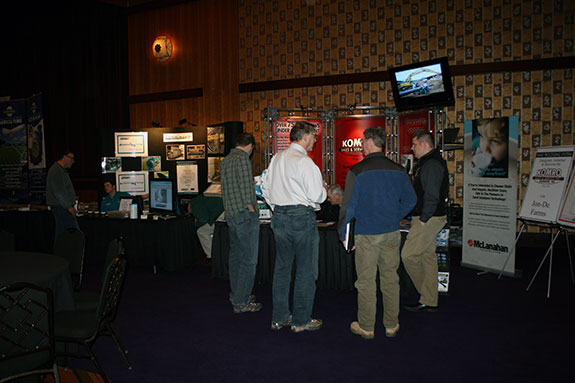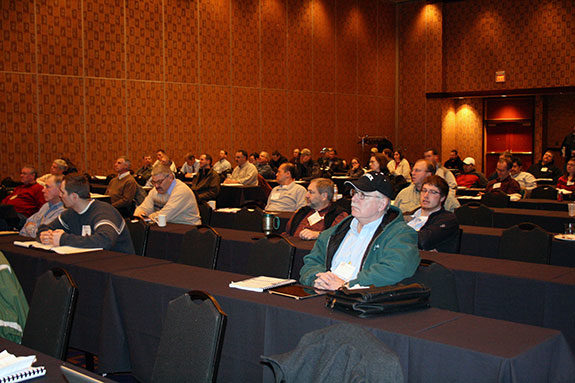As snow blankets the Midwest, February is a good time to take an in-depth look at how to manage one of the largest materials produced on farms.
The Midwest Manure Summit is a biennial event hosted by University of Wisconsin – Extension. It was held Feb. 26 and 27 in Green Bay, Wisconsin.
Rick Stowell from the University of Nebraska – Lincoln opened the event by looking at best management practices for reducing odor and emissions.
“Odor is a real concern for most dairies,” Stowell said. “Like mastitis and lameness, it is something that needs constant attention.”
Another area that should be of concern to many dairy farms is ammonia emissions.
He encouraged the use of the National Air Quality Site Assessment Tool (NAQSAT) to identify areas on an individual farm where there are opportunities to make changes that result in reduced air emissions.
Click here to learn more about NAQSAT.
“In my book, land application is where it's at in terms of priorities for odor,” Stowell said. To aid producers in remembering key points about land application, he wrote the following poem:
“Get it below,
Keep it low,
Think about how the wind will blow,
Manage how your neighbors know.”

There is growing interest in biochar, an end product of pyrolysis. According to Dr. Keri Cantrell with USDA-ARS , manure-based biochars are more nutrient-rich and have a more alkaline pH than plant-based biochars.
“All biochar is not the same, and all soil needs are not the same,” she said. However, the differences will allow the targeting of certain soil attributes with varying types of biochars.
While not commercially available quite yet, there are some companies coming online with pyrolysis units in the Chesapeake Bay area, focusing on poultry and turkey manure.
After lunch, attendees were treated to a virtual tour of the Dane County Digester. A community anaerobic digester, owned by a third party, that processes manure from three dairies within one half-mile of the site.
In the first breakout session, Loren Wolfe, a partner in Rosenholm Wolfe Dairy, shared how the farm has made a market for its manure.
To find another avenue of removing manure from the farm in western Wisconsin, the 550-cow dairy with 500 head of youngstock built a compost operation. This adds diversification to the dairy, which really helps in low milk price years like 2009, Wolfe said.
Click here to learn more about Wolfe's compost operation.
Another Wisconsin dairy operation profiting from manure is Holsum Dairies LLC.
Dr. Bob Nagel manages the two locations, each one equipped with a modified plug-flow anaerobic digester. He ran the income and expense for the digester and came up with a 28 percent return on investment.
“I think that’s a pretty good number,” Nagel said.
Because anaerobic digestion heats manure for an extended amount of time, it is believed that the process reduces the pathogen load in the manure. Mark Borchardt with USDA-ARS investigated this claim in a full-scale operational setting.
Nine farms were enrolled in a study. Seven farms had mesophilic anaerobic digesters and two had screw-press bedding recovery units.
Borchardt’s preliminary conclusions from the study are that full-scale digestion reduces pathogen levels by 90 to 99.9 percent. However, this is highly variable depending on the pathogen type, farm and time.
He also noted that after separation, the liquid fraction contained the majority of the pathogens. While the solids fraction contained few pathogens, Borchardt did point out that the concentration there could still be above the infectious dose, particularly for calves.
The National Air Emissions Monitoring Study began seven years ago. It was funded by checkoff dollars from a number of species, conducted by multiple universities and done with EPA oversight.
Dr. Al Heber from Purdue University reported on results pertaining to the monitoring of emissions from dairy facilities.
The study monitored ammonia, hydrogen sulfide, particulate matter, carbon dioxide, methane, nitrous oxide and other emissions. For the most part, emission rates were within the EPA’s standards.
Heber concluded, “We can get back to worrying about odor and don’t have to worry about these other regulations.”
Dr. Daniel Zitomer of Marquette University cleared up some myths and misconceptions about anaerobic digesters.
He said that any seed biomass doesn’t cut it for getting a digester started. A biomass should be tested to make sure it contains active bacteria that will get right to work.
People also tend to think in terms of aerobic environments instead of the anaerobic environment of digesters, Zitomer said. Anaerobic reactors can work faster and are just as susceptible to toxicants.
Revisiting the issue of odor in a breakout session, Stowell said the first step to odor mitigation is proper siting of livestock facilities.
Siting is not just about separation distance, he continued. It’s also about identifying the risk levels within various setback zones.
Stowell also reviewed various methods of odor abatement, including mechanical separation with polymers, anaerobic digestion, low-tech lagoons, aeration, manure additives, composting, permeable and impermeable covers, and biofilters.
State Conservation Engineer for USDA-NRCS in Madison, Wisconsin, John Ramsden shared the agency’s concerns to human safety, surface water and subsurface water. He also reviewed how recent revisions to NRCS standards address those concerns.
Some of these changes were necessary because the liquid percentage entering storage is increasing from more milking center wastewaters, feed storage runoff that needs to be captured and the implementation of solid separation systems that remove solids from storage.
Speaking of separation systems, Nancy Gleasman, sales/marketing manager for Aqua Innovations LLC, explained the NuWay technology that extracts a dischargeable liquid from manure using drum separation, centrifugal separation, ultra-filtration and reverse osmosis.
To conclude the Summit, Marcia Endres from the University of Minnesota shared the results of a study looking at using recycled manure solids for bedding.
She found that deep-bedded herds had a lower prevalence of lameness and hock lesions compared to those with recycled solids on mattresses. However, herds with recycled solids on mattresses had a lower prevalence when compared to studies of cows on mattresses bedded with straw or sawdust.
There was no difference in somatic cell count between digested, separated and bedding recovery unit solids. The incidence of clinical mastitis was two times greater than with other types of bedding. Endres said attention to cow prep at milking is very crucial with this bedding material. PD
PHOTOS
TOP: An overnight snowfall, made for a smaller crowd the second day of the Summit.
BOTTOM: A tradeshow at the Midwest Manure Summit allowed participants to see some of the latest technologies for managing manure. Photos by PD Editor Karen Lee.

Karen Lee
Editor
Progressive Dairyman magazine





